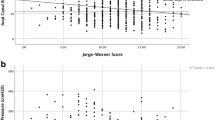Abstract
We aimed to determine if the type of clinical presentation in patients with faecal incontinence correlated with the underlying sphincter pathology. One hundred fifty one consecutive patients (129 female) with faecal incotinence were classified as having either passive (faecal incontinence without the patient's knowledge) or urge incontinence (incontinence occuring with the patient's awareness, against their will because of lack of voluntary control), and were investigated by routine anorectal physiological testing and anal endosonography. Sixty six patients had passive incontinence (PI) only, 42 patients had urge incontinence (UI) only, 38 patients had combined passive and urge incontinence, and 5 patients had soiling after defaecation only. Patients with PI alone (n=66) were significantly older than those with UI alone (PI vs UI, 60 vs 42 yr, p<0.001), had a lower maximum resting anal pressure (51 vs 64 cm H2O, means, p=0.02) and had a significantly (p<0.001) greater prevalence of internal anal sphincter (IAS) defects. Patients with UI alone (n=42) had a significantly lower maximum voluntary contraction pressure (PI v UI, 72 v 42 cm H2O, p<0.001), and a significantly (p<0.001) greater prevalence of external anal sphincter (EAS) defects. The clinical classification of faecal incontinence into passive and urge incontinence relates to specific patterns of abnormality of the internal and external anal sphincters.
Résumé
Le but de ce travail est de déterminer si le mode de présentation clinique des patients avec incontinence fécale peut étre corrélé avec la pathologie sphinctérienne sous-jacente. Cent-cinquante-et-un patients consécutifs (129 femmes) avec incontinence fécale ont été classifiés comme ayant une incontinence passive (sans que le patient n'en ait conscience), une incontinence de stress (incontinence dont le patient est conscient mais à laquelle il ne peut pas s'opposer en raison de l'absence de contraction colontaire). Ces patients ont été investigués par des épreuves physiologiques ano-rectales de routine et par une échographie endo-anale. Soixante-six patients étaient porteurs d'une incontinence passive (PI), 42 patients avaient une incontinence de stress (UI), 38 patients avaient une combinaison d'incontinence passive et d'incontinence de stress et 5 patients avaient une incontinence et un soiling aprés exonération uniquement. Les patients avec incontinence passive seule (n=66) étaient plus âgés, de manière significative, que ceux porteurs d'une incontinence de stress seule (PI vs UI, 60 vs 42 ans, p<0.001) et avaient une pression maximale de repos du canal anal plus basse (51 vs 64 cm d'H2O, moyenne, p<0.02) et présentaient une prévalence plus importante de lésions du sphincter interne (p<0.001). Les patients avec incontinence de stress (n=42) avaient une pression de contraction volontaire maximale abaissée (PI vs UI, 72 vs 42 cm d'H2O, p<0.001) et une prévalence plus grande de lésions du sphincter externe (P<0.001). La classification clinique des incontinences en incontinences passives et incontinences de stress correspond à des anomalies spécifiques du sphincter interne et du sphincter externe.
Similar content being viewed by others
References
Pescatori M, Anastasio G, Bottini C, Mentasti A (1992) New grading and scoring for fecal incontinence: evaluation of 335 patients. Dis Colon Rectum 35:28–30
Lane RN (1975) Clinical application of anorectal physiology. Proc Roy Soc Med 68:28–30
Kelly JH (1972) The clinical and radiological assessment of anal incontinence in childhood. Aus N Z J Surg 42:62–63
Felt Bergsma RJ, Klinkenberg Knol EC, Meeuwissen SG (1990) Anorectal function investigations in incontinent and continent patients: differences and discriminatory value. Dis Colon Rectum 33:479–486
Law PJ, Bartram CI (1989) Anal endosonography: technique and normal anatomy. Gastrointest Radiol 14:349–353
Sultan AH, Nicholls RJ, Kamm MA, Hudson CN, Beynon J, Bartram CI (1993) Anal and endosonography and correlation with in vivo and in vitro anatomy. Br J Surg 80:508–511
Rogers J, Laurberg S, Misiewicz JJ, Henry MM, Swash M (1989) Anorectal physiology validated: a repeatability study of the motor and sensory tests of anorectal function. Br J Surg 76:607–609
Jameson JS, Chia YW, Kamm MA, Speakman CTM, Chye YH, Henry MM (1994) The effect of age, sex and parity on anorectal function: a prospective study in healthy volunteers. Br J Surg 81:1689–1692
Kiff ES, Swash M (1984) Slowed conduction in the pudendal nerves in idiopathic (neurogenic) faecal incontinence. Br J Surg 71:614–616
Rogers J, Henry MM, Misiewicz JJ (1988) Disposable pudendal nerve stimulator: evaluation of the standard instrument and new device. Gut 29:1131–1133
Farthing MJG, Lennard Jones JE (1978) Sensibility of the rectum to distension and the anorectal distension reflex in ulcerative colitis. Gut 19:64–69
Kamm MA, Lennard Jones JE (1990) Rectal mucosal electrosensory tests—evidence for a rectal sensory neuropathy in idiopathic constipation. Dis Colon Rectum 33:419–423
Roe AM, Bartolo DCC, Mortensen NJMcC (1986) New methods for assessment of anal sensation in various anorectal disorders. Br J Surg 73:310–312
Read M, Read NW, Duthie HL (1982) Effects of loperamide on anal sphincter function in patients complaining of chronic diarrhoea with faecal incontinence and urgency. Dig Dis Sci 27:807–814
Engel AF, Kamm MA, Sultan AH, Nicholls RJ, Bartram CI (1994) Anterior anal sphincter repair for patients with obstetric trauma. Br J Surg 81:1231–1234
Sultan AH, Kamm MA, Talbot IC, Nicholls RJ, Bartram CI (1994) Anal endosonography: precision of identifying external sphincter defects confirmed histologically. Br J Surg 81:463–465
Swash M, Gray A, Lubowski DZ, Nicholls RJ (1988) Ultrastructural changes in internal anal sphincter in neurogenic faecal incontinence. Gut 29:1692–1698
Lubowski DZ, Nicholls RJ, Burleigh DE, Swash M (1988) Internal anal sphincter damage in neurogenic fecal incontinence. Gastroenterology 95:997–1002
Snooks SJ, Setchell M, Swash M, Henry MM (1984) Injury to the innervation of pelvic floor musculature in childbirth. Lancet 2:546–550
Delechanaut P, Leroi AM, Weber J, Touchais JY, Czernichow P, Denis P (1992) Relationship between clinical symptoms of anal incontinence and the results of anorectal manometry. Dis Colon Rectum 35:847–849
Author information
Authors and Affiliations
Rights and permissions
About this article
Cite this article
Engel, A.F., Kamm, M.A., Bartram, C.I. et al. Relationship of symptoms in faecal incontinence to specific sphincter abnormalities. Int J Colorect Dis 10, 152–155 (1995). https://doi.org/10.1007/BF00298538
Accepted:
Issue Date:
DOI: https://doi.org/10.1007/BF00298538




